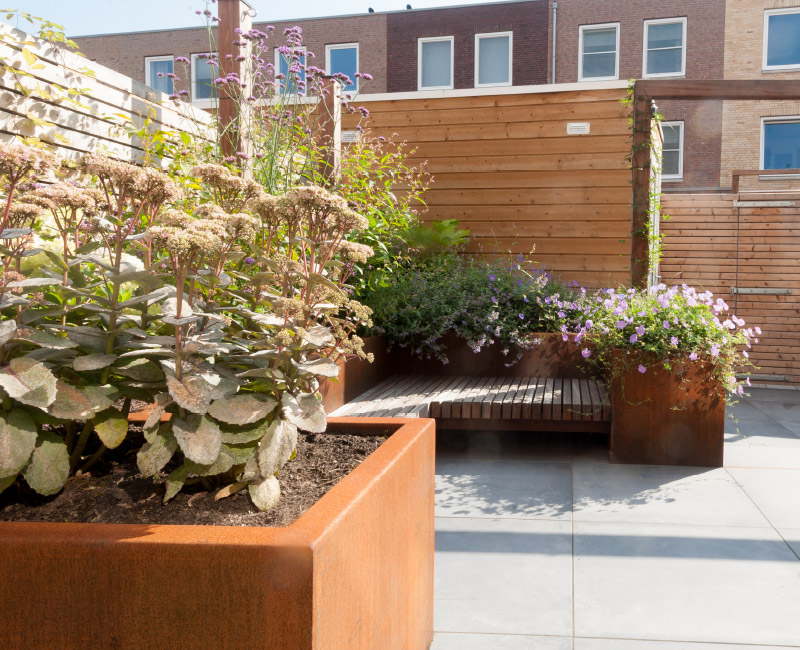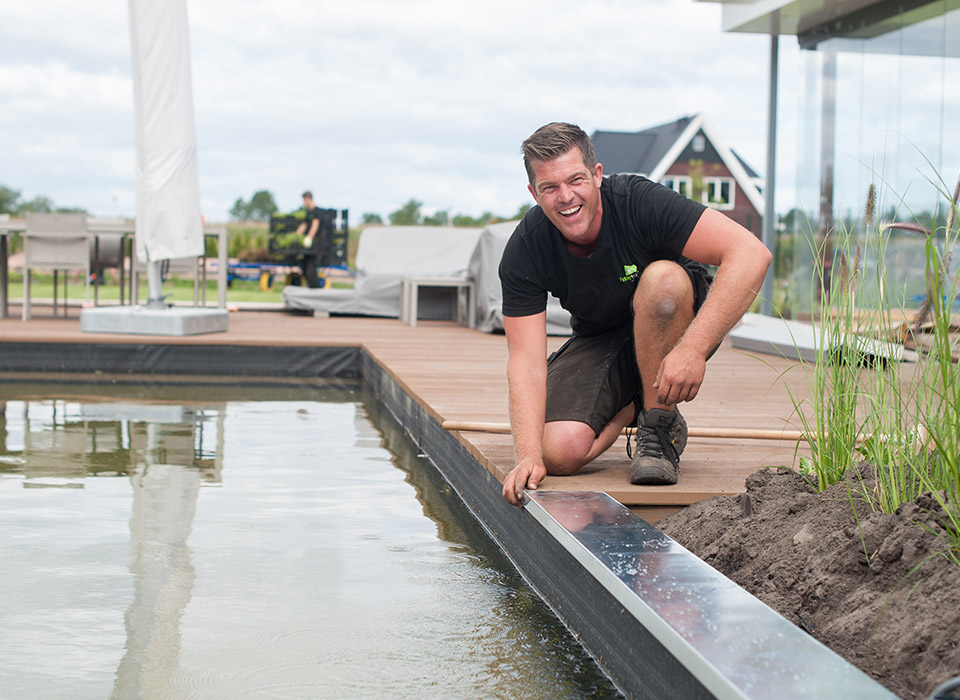Qualified landscaper in Leimuiden
Who are we?
We’re Visser Tuinen, a qualified landscaper from Leimuiden with 30 years of experience. We’re committed to originality and the highest quality in garden design and landscaping. We work for both private individuals and business customers in various locations.

Garden design Leimuiden
We have all the professional skills in-house to realise a complete concept. Our experienced garden designers, with their years of experience and craftsmanship, can convert all your garden wishes into creative garden designs. Your budget and the available space are looked at closely. Whatever size your garden, Visser Tuinen can provide you with a perfectly suitable and breath-taking garden design!
Garden landscaping Leimuiden
Have you approved the design and quote? Then we can get started on landscaping your garden! We make sure that everything is perfect down to the last detail, because we want you to enjoy your garden for a lifetime.
Garden maintenance Leimuiden
A garden needs maintenance to keep it in tip-top condition. Visser Tuinen is more than willing to help you in this respect. Whether you enjoy doing the gardening yourself and only occasionally need some advice and help, or want the entire care of your garden taken off your hands, Visser Tuinen always has a suitable maintenance package available.

Tree surgery Leimuiden
In addition to designing, constructing and maintaining gardens, we can also advise you on planting, pruning, transplanting and caring for trees. Trees are essential elements for a healthy environment: just think of cooling, filtering the air and biodiversity, to name but a few of the benefits.
Contact
Interested in what we can do for your garden? Then don’t hesitate to contact us!
In addition to designing, constructing and maintaining gardens, we can also advise you on planting, pruning, transplanting and caring for trees. We are certified by Groenkeur, and a member of the Knowledge Association for Tree Surgeons (KPB). Our tree inspections are conducted by Peter van Leeuwen, our European Tree Worker (ETW).
Frequently asked questions
How much does it cost to create a garden design?
Do you visit without obligation if I have questions about a design?
How can I prevent weeds growing in the joints in my paving?
I’m building a new home. When’s the best time to get Visser Tuinen involved?
When’s the best time to plant a garden? Is it also possible in winter?
Do you also supply all the materials needed to landscape a garden?
How much does it cost to landscape a garden?
Is a planting plan drawn up for each individual garden?
Is a lighting plan drawn up for each individual garden?
Do I need planning permission for a summer house or gazebo in the garden?
What is the maximum height of the boundary fence?
Does Visser Tuinen provide a warranty on the gardens it landscapes?
I’d like to have lots of butterflies and bees in my garden. How do I make my garden attractive to them?
How can I increase biodiversity in my garden?
- Plant a hedge instead of erecting a fence.
- Think about putting a pond in your garden, or provide water bowls; insects and birds love water.
- Make sure you have a wide variety of flowers that bloom in different seasons. By selecting plants in this way, you’ll be able to enjoy your garden more throughout the year.
- If you have enough space in your garden, you can place some wattle walls. These provide shelter for small animals such as amphibians, hedgehogs, and birds. If your garden is smaller, you can also place mounds of branches and leaves for guests such as hedgehogs.
- Another good idea is to hang up a bee hotel where bees can nest and hibernate,
- Hang up some birdhouses to provide shelter for our feathered friends.
- Avoid using chemical pesticides and herbicides in your garden.
- You can also rewild an area of your garden, where nature can take its course.
What types of paving allow water to pass through?
Should I disconnect my roof drainpipes from the sewer and divert rainwater to rain barrels in the garden?
Can I get a subsidy for a green roof?
Can I turn an existing wall into a green wall?
When’s the best time to plant fruit trees and other trees?
Do you supply instant hedges?
What are the rules concerning trees, shrubs, and the property boundaries?
- Trees must be at least 2 metres from the property boundary
- Hedges and shrubs must be at least 50 cm from the property boundary
- A tree or hedge which is not higher than the fence
- After 20 years, your right to demand the relocation of a tree or hedge ends. This is called the ‘statute of limitations’ in legal jargon.
How often should I water my plants and my lawn?
How do I install paving on soft soil?
- Avoid using paving: You could consider not using hard paving at all, but wooden decking. Decking planks are supported by underlying beams. Decking allows rainwater to drain more easily, so you’re less likely to experience puddles forming in your garden or, worse still, flooding.
- Solid base layer: Create a solid base layer before placing the paving. This could be a layer of fine rubble or crushed sand.
- Lightweight base layer: Sometimes, raising the surface with crushed sand isn’t the best solution, and a combination of materials works better. A lightweight structure based on EPS (expanded polystyrene) may be a solution. This helps maintain stability in the soil, and relieves the base. This synthetic filling material is also sold under the brand names Styrofoam and Tempex. Another option is YALI, a volcanic material that is also used for lightweight foundations. YALI is very easy to use. What’s best for your specific situation depends on various factors, but Visser Tuinen will gladly provide you with more information.
- Drainage: Make sure there’s enough drainage capacity, so that water can drain easily and the soil doesn’t become waterlogged. Solutions include installing drainage pipes or using permeable paving.
- Compaction: Thoroughly compact the surface before placing the paving. A tool such as a plate compactor helps with this job.
- Edging: Make sure the edging of the paving is resistant enough to hold the paving in place.
Help, my leaves are being eaten! What can I do?
How can I improve my plants’ resistance to pests?
My garden remains waterlogged for a long time. Can I do anything about it?
- Install a drainage system: If the soil above the groundwater level is waterlogged, you might have to install a drainage system so that the water can drain to a lower location. Such a system consists of ribbed tubes with thousands of holes in the walls, covered with coconut fibre. They do have to lead to some point where the water can go, and this must be lower than the drainage pipe.
- Aeration: Regularly aerating the lawn helps the lawn and underlying soil absorb water, reducing the likelihood of puddles forming on the grass.
- Improve the soil structure: Soils that retain a lot of moisture, such as clayey and loamy soil, are much more sensitive to heavy rain. If your garden contains this type of soil, it’s a good idea to spread a thin layer of sand each winter to improve the soil structure. This will help rainwater soak into the soil.
- Create a wadi: A garden wadi (a type of soakaway) is a lowered area in your garden where rain can collect, and then infiltrate the soil. This both prevents water accumulating where you don’t want it, and stimulates biodiversity; it will become a habitat for plants and animals that can withstand water and drought. In addition, a wadi can reduce the burden on the sewer system if rainwater drains are connected to it.
- Install an infiltration box: This is a large capacity box into which water can penetrate easily. The box acts as a buffer; it fills up with water in heavy rain, after which the water can gradually infiltrate the surrounding soil. One of the advantages is that it takes pressure of the sewers, as water can be directed to the box instead.
- Grate gutters (drainage gutters): Placing grate gutters or channel gutters around the edge of the lawn works really well. Excess water is collected by the gutters, and discharged to the sewer.
My neighbours’ trees are a nuisance, can I do anything about this?
Cats are causing a lot of nuisance in my garden. What can I do?
My garden is shady, with little direct sun. Which plants will give me enough colour in my garden?
- Lungworts (Pulmonaria)
- Wolf’s bane (Aconitum)
- Columbine (Aquilegia)
- Crane’s bill (Geranium)
- Bleeding heart (Dicentra)
- Bugle (Ajuga reptans)
- Lenten rose (Helleborus orientalis)
- Plantain lilies (Hosta)
- Barrenwort (Epimedium)
- Great forget-me-not (Brunnera)
 EN
EN NL
NL
